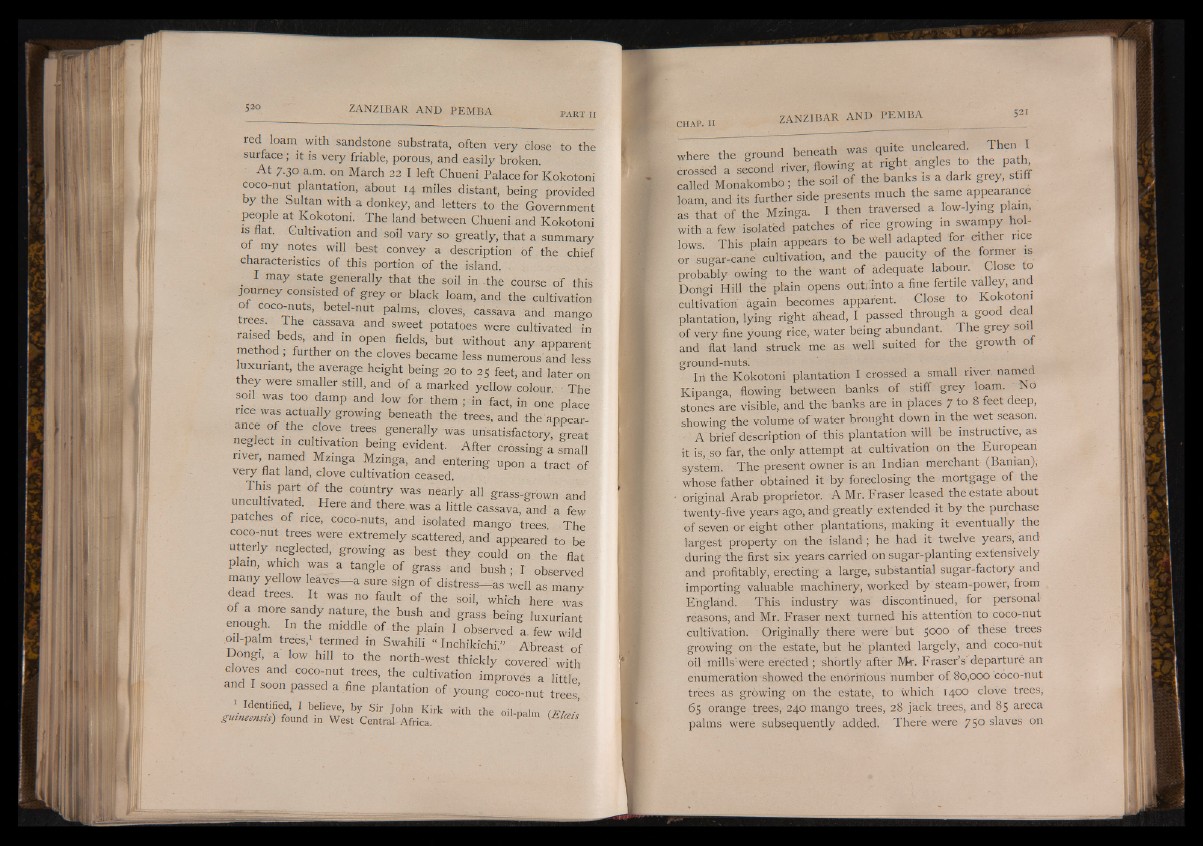
red loam with sandstone substrata, often very close to the
surface ; it is very friable, porous, and easily broken.
A t 7.30 a.m. on March 22 I left Chueni Palace for Kokotoni
coco-nut plantation, about 14 miles distant, being provided
by the Sultan with a donkey, and letters to the Government
pepple at Kokotoni. The land between Chueni and Kokotoni
is flat. Cultivation and soil vary so greatly, that a summary
of my notes will best convey a description of the chief
characteristics of this portion of the island.
. 1 ma-y state generally that the soil in the course of this
journey consisted of grey or black loam, and the cultivation
of coco-nuts, betel-nut palms, cloves, cassava and mango
rees. The cassava and sweet potatoes were cultivated in
raised beds, and in open fields, but without any apparent
method ; further on the cloves became less numerous'and less
luxuriant, the average height being 20 to 25 feet, and later on
they were smaller still, and of a marked yellow colour. The
soil was too damp and low for them ; in fact, in one place
rice was actually growing beneath the trees, and the appearance
of the clove trees generally was unsatisfactory, great
neglect in cultivation being evident. After crossing a small
river named Mzinga Mzinga, and entering upon a tract of
very flat land, clove cultivation ceased.
This part of the country was nearly all grass-grown and
uncultivated. Here and there was a little cassava, and a few
pa c es o rice, coco-nuts, and isolated mango trees The
coco-nut trees were extremely scattered, and appeared to be
utterly neglected, growing as best they could on the flat
plain, which was a tangle of grass and bush ; I observed
many yellow le a v e s -a sure sign of distress-as well as many
dead trees. It was no fault of the soil, which here was
of a more sandy nature, the bush and grass being luxuriant
enough. In the middle of. the plain I observed a. few wild
.oil-palm trees, termed in Swahili “ Inchikichi!” Abreast of
Dongi, a low hill to the north-west thickly covered with
cloves and coco-nut trees, the cultivation improvës a little
and I soon passed a .fine plantation of young coco-nut trees,’
1 Identified, I believe, by Sir John Kirk with the oil-nalm ( F / J
gutneensis) found in West Central-Africa.
where the ground beneath was quite uncleared. Then I
tossed a second river, flowing at right angles to the path
called Monakombo ; the soil of the banks is a dark grey,
loam, and its further side presents much the same appearance
as that of the Mzinga. I then traversed a low-lying plain,
with a few isolated patches of rice growing in swampy hollows.
This plain appears to be well adapted for either rice
or sugar-cane cultivation, and the paucity of the former is
probably owing to the want of adequate labour. Close to
Dongi Hill the plain opens outunto a fine fertile valley, and
cultivation again becomes apparent. Close to Kokotoni
plantation, lying right ahead, I passed through a good dea
of very fine young rice, water being abundant. The grey soil
and flat land struck me as well suited for the growth of
ground-nuts! ! .
In the Kokotoni plantation I crossed a small river, named
Kipanga, flowing between banks of stiff grey loam. No
stones are visible, and the banks are in places 7 to 8 feet deep,
showing the volume of water brought down in the wet season.
A brief description of this plantation will be instructive, as
it is, so far, the only attempt at cultivation on the European
system. The present owner is an Indian merchant (Banian),
whose father obtained it by foreclosing the mortgage of the
• original Arab proprietor. A Mr. Eraser leased the estate about
twenty-five years ago, and greatly extended it by the purchase
of seven or eight other plantations, making it eventually the
largest property on the island ; he had it twelve years, and
during the first six years carried on sugar-planting extensively
and profitably, erecting a large, substantial sugar-factory and
importing valuable machinery, worked by steam-powér, from
England. This industry was discontinued, for personal
reasons, and Mr. Fraser next turned his attention to coco-nut
cultivation. I Originally there were but 5000 ° f these trees
growing on the estate, but he planted largely, and coco-nut
oil miils:were erected ; shortly aftèr M*. Fraser’s departure an
enumeration showed the enormous number of. 80,000 coco-nut
trees as growing on the estate, to which 1400 clove trees,
65 orange trees, 240 mango trees, 28 jack trees, and 85 areca
palms were subsequently added. There were 750 slaves on